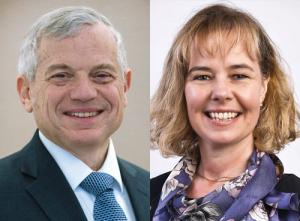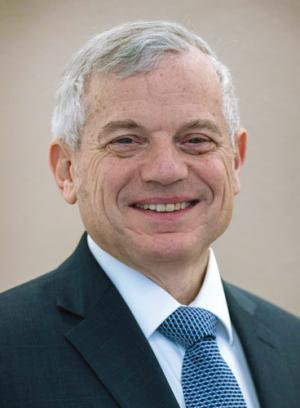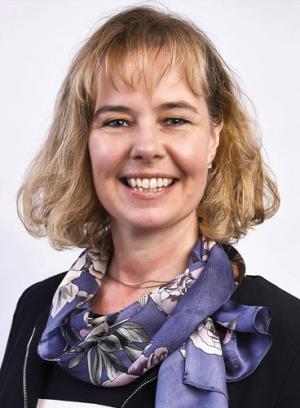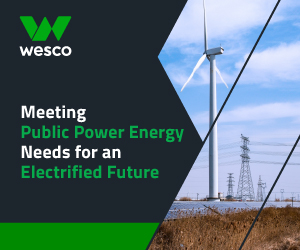NYPA, Cadenza Innovation
Alan Ettlinger is the director for research, technology development and innovation at the New York Power Authority.
Christina Lampe-Onnerud is the CEO of Cadenza Innovation.
his is such an important conversation for you to listen in on. For, if we're to come anywhere close to net zero carbon emissions, our industry will need to position energy storage everywhere throughout the grid, even in densely-populated cities. How exactly is that supposed to happen — when storage needs to be placed next to schools, senior citizen centers, day care facilities, hospitals, etc. — if the batteries have any safety risks whatsoever?

Well, it turns out that the New York Power Authority and some brilliant scientists at Cadenza Innovation may have figured this out. Cadenza CEO Christina Lampe-Onnerud and her team have reengineered the innards of lithium ion batteries to make them intrinsically invulnerable to fire risk. Cool! In more ways than one. See below how Dr. Lampe-Onnerud and her sidekicks at Cadenza and NYPA are reengineering the path to net zero.
PUF's Steve Mitnick: Christina, you are the head of Cadenza Innovation. Where did the name originate?
Christina Lampe-Onnerud: Cadenza comes from the world of music. It's when all the musicians play together in harmony and you allow one musician to come up with a new idea, creative content, and the other musicians come around that idea, support it, and let it flourish.
That exists in classical music toward the end, of the symphony typically, when the virtuoso gets creative. Everybody holds and you wait, and we have this tension and then you have the release. It happens in jazz all the time. That's how we run innovation programs.
 Allan Ettinger: The mandate we have in R&D and at the Power Authority, as our CEO says, is we want to be the first. What attracted us to this is the safety of the technology and of the product.
Allan Ettinger: The mandate we have in R&D and at the Power Authority, as our CEO says, is we want to be the first. What attracted us to this is the safety of the technology and of the product.
PUF: Alan, you're from NYPA. What instrument do you play?
Alan Ettlinger: As my wife says to me, I'm tone deaf. I can't sing. I could listen to music, but I'd rather listen to sports. It's fortunate that this is not developing a new type of concert, a new type of instrument. We've got something good here, but it's not musical.
PUF: Your two organizations got together and started making amazing music at the White Plains office, the headquarters of the New York Power Authority. How did that begin?
Christina Lampe-Onnerud: The New York Power Authority is well known as an authority with data analytics, knowledge, solid engineering, and R&D — they're one of the most capable players driving the energy transition in the United States.
 Christina Lampe-Onnerud: It was rewarding as an innovator to get the calls where they said, we’re going to blow up your battery. We said, we don’t think so. We know how to do this. It didn’t explode.
Christina Lampe-Onnerud: It was rewarding as an innovator to get the calls where they said, we’re going to blow up your battery. We said, we don’t think so. We know how to do this. It didn’t explode.
The introduction came through the U.S. Department of Energy. Within Cadenza Innovation, a third of our team had previously worked together at a different battery company, Boston-Power, which I started in 2005. During that time, we learned a lot about developing and deploying portable power in laptops, cell phones, and some of the first electric cars.
We deployed some storage technology into India on solar panels in rural villages. Then, we stepped back from that venture and said, wouldn't it be cool to do something crazy?
I said, we should play it safe by giving safety a premium seat at the design table. We should develop a battery that could not explode and, at the same time, a battery that people could afford.
That way, we would help facilitate a powerful transition from the old energy paradigm into something using more modern technology. We could have friends all over the place and we could create economic opportunities. What about that?
Everybody said, that's crazy. Let's look at it. We had some ideas. We got a call from the U.S. Department of Energy and they said, we know about your previous company. We know you're capable. If you want to chat, we have this opportunity in electric vehicles. We have thoughts about what the United States should do with innovators. We want to make sure you stay in the United States. We said, we're staying. Let's do something cool.
We had meetings. I'm an alum of MIT. We met at MIT in the conference rooms and presented this dream. The DOE said, that is crazy. Nobody before had said we can have low cost, high safety, and high performance. It's always two out of the three. Why not?
They gave us a grant to explore this idea. A lot of our early ways to develop this idea didn't work, but as we exited their program in 2018, we had reached the key milestone of a successful demonstration with Fiat Chrysler in Los Angeles, in an electric car, which was at the time one of the hotbeds for trials and trepidations.
When that successfully occurred, the DOE said to the DOD, why don't you blow up these cells? You're good at that. That's your core. They took the technology through a range of destructive testing and evaluated its ability not to explode.
It was rewarding as an innovator to get the calls where they said, we're going to blow up your battery. We said, we don't think so. We know how to do this. It didn't explode. With that, there was this hand-over between DOE and DOD, and then from DOE out to different states in the U.S.
They had a council focusing on what's next in the U.S. in energy, and multiple states participated. When they presented the idea behind Cadenza and our technology platform, they said, we don't know everything about this, but it looks like there's something new here. It could have enormous potential. Multiple states said, we want to try this. But, New York said, we want it now.
Since we'd be working with a local team, we said, that sounds nice. I've traveled to Asia and lived on airplanes.
Having friends in the neighborhood, NYPA with all its capability, is wonderful. Also, NYSERDA, the New York State Energy Research and Development Authority, is putting weight behind it and the Governor is saying, I want this.
I have served for many years on the board of NY-BEST, the New York Battery and Energy Storage Technology Consortium, which is a public-private partnership around storage, helping build a policy, shaping a policy of what is realistic, what is not realistic, what is a dream, what is fact, what's fable, as well as trying to encourage the ecosystem in New York and the greater United States.
We had a lot of friends inside the state and the state wanted it. Then, ABB came in and said, we have looked at this. NYSERDA said, would you like to be an adviser to a phase one? ABB said, sure.
Then, we had a phase one, which was a paper study. When it came out, the reviewers thought, this is better than any of the soft programs. This has potentially an opening going forward for a real shift in how we think about storage and how we think about electricity.
The dream of innovators in this space is that you diversify and implement modern technologies into infrastructure. The conundrum was how can you make it affordable? How can you make it reliable enough? ABB said we had a commercial partner. Then NYPA came in and said, we're doing it. It was a perfect partnership.
PUF: Alan, what did you think?
Alan Ettlinger: To set the background, New York State has something called the New York State Climate Leadership and Community Protection Act. Part of that mandate is Governor Cuomo's goal of having three gigawatts of storage by 2030.
The mandate we have in R&D and at the Power Authority, as our CEO says, is we want to be the first. What attracted us to this is the safety of the technology and of the product.
New York State has a number of large cities like New York City, White Plains, Syracuse, and Albany. It's our feeling that in order to reach the Governor's goals, we will have to put energy storage in an urban environment, and we need to make it safe.
There was a significant fire out in Surprise, Arizona with lithium-ion batteries, which was using the standard existing technology. There was also, earlier this year, a major fire in Europe. We were interested in something new, being first to try new technology, and that's what attracted us.
It has been a great partnership between us and Cadenza. We're close to turning on the switch. That's shown that this public-private partnership does work. That's part of what made this effort exciting, but again, it's to be the first, to be new, with something that helps meet the Governor's goals.
There are other technologies. We were attracted to this. We are looking at long-term flow batteries and so forth, but this is the niche we think we've got to get into.
The battery we started to install is going to be located eight feet away from our White Plains office. It shows we feel the safety is there. We feel the technology is there.
We've worked with the White Plains Fire Department and the New York City Fire Department. We brought in external partners and had them look at it to make sure somebody's looking over our shoulders. We've got the experience in batteries and in fire protection.
PUF: Christina, how did you come up with this? What is this technology?
Christina Lampe-Onnerud: I am a chemist with a minor in mathematics, postdoc at MIT. The idea comes from a fundamental place. I'm grateful for the opportunities to participate in the World Economic Forum and was also an Entrepreneur of the Year.
I am super driven to be part of solutions for the future. It inspires me that you can take what you know and find other people and put together unlikely partnerships. Alan and I represent an unlikely partnership where we have created a little bit of a King Arthur's table.
Cadenza has some of the world's leading authorities who have lots of experience in battery technology. Alan and his teams bring one aspect of what we're trying to do. ABB brings another.
We get a lot of credit for the technical innovation, but when we look back ten years from now, we will be most proud of how we have been able to partner. We have loved working with NYPA because there is a dedication to data.
None of us came to this and said, we know everything. We found a group of people willing to sit at the table long enough to say, we're committing to solving problems together. That's the magic. You have all these credentials and all this experience. There's rarely a lack of technology.
Cadenza brought the safety to the inside of the battery, instead of having to patch it around the battery, which is the traditional way. Of course, you can put a mediocre battery into a steel chest and put fire blankets all around it. It becomes big and expensive, but it's safe.
What we have done is to put the knowledge of what safety means and paired it precisely with the application. That is where we are showcasing the beginning of what could become a new era.
PUF: How's it going to work? What will it look like? How long will it store energy?
Alan Ettlinger: The battery is a two hundred and fifty kilowatt hour battery. The initial battery is relatively small. It's meant to be for peak shaving. Peak shaving means that you want to store the energy when electricity is less costly. Then, you want to use it when electricity is more expensive.
That's the demonstration. The battery can be used for blackouts and other purposes, but this is the application that we want to demonstrate. It's bigger than a bread box, but it's not as big as a building. It's relatively small.
We're going to try this out for a short period of time. Then, we have the option to go up to the next size. We've already started discussions with Christina about taking this to the next step. We feel it needs to be done in steps, because it's new technology.
We feel we can rapidly get to the point where we can get to a bigger battery that can do a heavy lift on the energy peak shaving, at least with the buildings we have and also for the rest of our customers.
NYPA's mission, in addition to providing low-cost energy to the citizens of New York, is also to support our customers in energy savings and energy solutions. We've entered this new area where we're looking at solutions for our customers.
The R&D function at the Power Authority includes research in generation and transmission, but also in customer solutions. This project fits initially into the smallest scale, and eventually will get into the larger grid-scale solution for energy storage.
PUF: Where's this going to be three, five, seven years out?
Christina Lampe-Onnerud: The fact that we have packaged lithium-ion technology in a LEGO block where you have all the safety inside allows for what you used to know as your cell phone technology to now be adopted to large scale.
You can lift it with one hand. You put them into modules. You stack the modules like cartridges into some level of shelf system. We call it racks and you stack those racks next to each other.
What is unique with our system is that you don't need additional safety between the cells, the modules, or the rack. It's already built in. When you're outside, you have to protect the batteries from the elements, but it is so easy to install, you could put it in your basement, elevator shafts, and attics. We've placed some on rooftops.
You have opportunities for scale. You can put in one rack or two hundred racks, depending on your need for power.
That fulfills the dream that we have been discussing and debating for so many years. What does distributed storage mean? Why do we need it? We need it because our infrastructure was built on a different way of operating.
Today, we have lots of peaks. With the pandemic it fast-forwarded into a new energy transition. The need to deploy storage locally to satisfy those new use modes, yet with an awareness that we have a climate change issue that we also would like to provide solutions to, is like the best of both worlds. You can save on your operating expense at the same time. That is the triple crown.
Alan Ettlinger: The technology that Cadenza brings is in the basic cell, and that cell has been designed to limit fire propagation, which is not the same as with the standard lithium-ion energy storage.
Standard lithium-ion storage is you take thirty thousand batteries, put them in a box, and turn on the switch. That's not what is here. This technology has inherently been designed and tested. That's where the key to this technology is.
PUF: Other utilities may say, if this works out, maybe we should look into this? Is that a possibility?
Christina Lampe-Onnerud: That would be the dream, of course. I live here by choice. I would like the United States to take the opportunity to capture its innovation and engineering competence and have us refuel our energy markets. We have so much knowledge.
Many of us were part of the traditional energy and electricity paradigm, and yet some of us are coming from the high-tech sphere, me included. We now have this roundtable opportunity where we've got to work together.
What a perfect storm to do things differently and capture this opportunity. It is here right now. It is obvious that the United States can lead if it wants to lead. The question is going to be how many Alans are out there and how many are out there curious about this? It's going to come down to people. Let's mobilize and do it.
Alan Ettlinger: Looking at this in perspective, with the move to wind, solar, and distributed energy, the sun doesn't shine twenty-four hours a day. It's the same with wind. You need to be able to capture that energy.
In addition to the goals the Governor set out, it's a practical need that we're trying to solve in the industry as to how to store this energy off-peak, so it can be used during peak.
This is going to be a market leader in getting to the ultimate goal of a hundred percent carbon-free.



